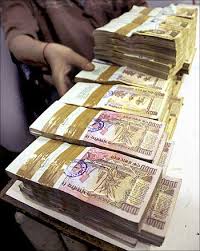 A United Nations officer issued a cheque
A United Nations officer issued a cheque on his nationalized bank account.
The cheque bounced despite his having
deposited a big sum a few days back.
He complained to the bank only to be
told that Rs 75,000 was withdrawn in
a number of transactions in Romania,
a country he has never visited.
 The police suspect that the account was
The police suspect that the account washacked on internet.
This is not the lone case of fraudulent
activity in an Indian bank. Bank fraud is
a big business in today's world. With more
educational qualifications, banking is becoming
impersonal and an increase in banking sector has
given rise to this white collar crime.
In many cases, the involvement of bank officials,
as deliberate colluders, is also suspected.
With the introduction of internet universal
banking, the number of bank frauds has more
than doubled in five years. There were 10,450 cases
of such cases in 2004-05, which rose to 13,914
in 2005-06 and 23, 914 in 2008-09.
 The figures are as per cases recorded with
The figures are as per cases recorded with the Central Bureau of Investigation.
It is assumed that there are many more cases,
which are settled at the banks' end and no
complaints are lodged officially.
The frauds have cost the depositors Rs 779 crore in
2004-05. It almost doubled to Rs 1381 crore the next
year. In 2008-09, the figure rose to Rs 1883 crore.
The figures given - Rs 4,043 crore in these deals -
are again not conclusive.

The actual figure may be much more.
Both bank and forensic officials are baffled
at this massive level of fraud. In 2004-05,
there were 96 cases in which over Rs 1 crore
was swindled away in each transaction.
This rose to 212 in 2008-09.
Apparently no depositor is safe.
Chances of swindling increase seemingly
with the size of the bank. A multi-crore
fake cheques scam estimated to the tune of
Rs 52 crore was exposed in the Kanpur main
branch of the State Bank of India last August.
 Seven bank officials, including one assistant
Seven bank officials, including one assistant general manager and two chief managers were
suspended. The bank's audit team found that
the fraud involved clearing of fake cheques in
the bank account of an influential petrol pump
owner. He is believed to have fled the country.
This is stated to be the biggest fraud
in the Kanpur-Lucknow region.
This banking fraud is basically classified as
fraud by insider and fraud by others.
It involves a highly placed insider nominally
authorized to invest sizeable funds on behalf of
the bank; as it happened in the Kanpur case.
This person secretly makes aggressive and risky
investments using the bank's money and when one
investment goes bad, he engages in further market
speculation in the hope of a quick profit, which
would hide or cover the loss. Many such transactions
found their way even to the stock market though
investments in other speculative activities are
also not uncommon.
Unfortunately, when one investment loss is
piled onto another, the costs to the bank
can reach into hundreds of crore of rupees.

Remember, many of the US and western banks
went out of business for such activities in 2008.
The banking fraud is classified as fraudulent
loans, wire frauds, forged or fraudulent documents,
uninsured deposits, theft of identity, demand draft
frauds, forgery and altered cheques, accounting fraud,
bill discounting fraud, credit card fraud, fraudulent
loan applications, phishing and internet frauds.
While some of these existed in one or the other form
even earlier, the magnitude was far less. New technology
has added to the woes of the investigators as it
not only involved complex accounting processes but
also complicated technology and software applications.

A computer crime may be committed in one country and
its result can be found in another country.
There has been a lot of jurisdictional problem
and though the Interpol helps, it too has its
limitations. Different treaties and conventions
have created obstructions in relation to tracking
of cyber criminals hiding or operating in other nations.
It is described as a no-scene crime. The usual crime
scene is the cyber space. The terminal may be anywhere
and the criminal need not indicate the place. The only
evidence a criminal leaves behind is the loss to the bank.
The major advantage the criminal has in instituting a
computer crime is that there is no personal exposure,
no written documents, no signatures, no fingerprints
or voice recognition. The criminal is truly and in the
strict sense faceless.
There are certain spy softwares which are utilized
to find out passwords and other vital entry information
to a computer system. The entry is gained through a spam
or bulk mail. This is called phishing.

A number of programmes called "Trojan horse"
programmes have also been used to snoop on the
internet users while online, capturing keystrokes
or confidential data.
The information thus stolen is then used in
other frauds, such as theft of identity or
online fraud. Though using debit and ATM card
is stated to be safe by banks, technological
experts say that pin numbers and other details
can easily be cloned or pilfered and misused as
one feeds the machine.
The experts also advice not to put
credit card ATM details ever on the internet
for any kind of transactions. The information
travels to a chain of computers and could be
intercepted at any point.
International internet transactions are
always fraught with risk. The CBI and banks
are now putting their heads together to
create a firewall and improve the forensic
techniques. However, the nature of transaction
that has to allow access to the accounts of
the banks pose a daunting challenge. Some elements
have suggested closing the direct internet transactions
at least at international level.
It is a matter of probe whether terrorist
groups are part of cyber crime or not.
The existing Indian laws are not at all adequate
to counter cyber crimes. The Indian Penal Code,
Evidence Act, and Criminal Procedure Code have no
clue about computers when they were codified.
The IT Act is there but it is inadequate.
Banks are clueless at stopping this crime.

The alternate is to utilize the banking services
in the conventional paper method till a
foolproof system evolves.
By Shivaji Sarkar
No comments:
Post a Comment